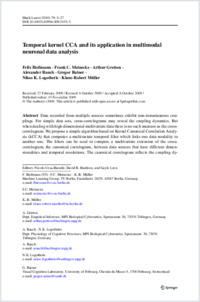Temporal kernel CCA and its application in multimodal neuronal data analysis
- Bießmann, Felix Machine Learning Group, TU Berlin, Germany
- Meinecke, Franck C. Machine Learning Group, TU Berlin, Germany
- Gretton, Arthur Dept. Empirical Inference, MPI Biological Cybernetics, Tübingen, Germany
- Rauch, Alexander Dept. Physiology of Cognitive Processes, MPI Biological Cybernetics, Tübingen, Germany
- Rainer, Gregor Visual Cognition Laboratory, University of Fribourg, Switzerland
- Logothetis, Nikos K. Dept. Physiology of Cognitive Processes, MPI Biological Cybernetics, Tübingen, Germany
- Müller, Klaus-Robert Machine Learning Group, TU Berlin, Germany
-
13.11.2009
Published in:
- Machine Learning. - 2010, vol. 79, no. 1-2, p. 5-27
English
Data recorded from multiple sources sometimes exhibit non-instantaneous couplings. For simple data sets, cross-correlograms may reveal the coupling dynamics. But when dealing with high-dimensional multivariate data there is no such measure as the cross-correlogram. We propose a simple algorithm based on Kernel Canonical Correlation Analysis (kCCA) that computes a multivariate temporal filter which links one data modality to another one. The filters can be used to compute a multivariate extension of the cross-correlogram, the canonical correlogram, between data sources that have different dimensionalities and temporal resolutions. The canonical correlogram reflects the coupling dynamics between the two sources. The temporal filter reveals which features in the data give rise to these couplings and when they do so. We present results from simulations and neuroscientific experiments showing that tkCCA yields easily interpretable temporal filters and correlograms. In the experiments, we simultaneously performed electrode recordings and functional magnetic resonance imaging (fMRI) in primary visual cortex of the non-human primate. While electrode recordings reflect brain activity directly, fMRI provides only an indirect view of neural activity via the Blood Oxygen Level Dependent (BOLD) response. Thus it is crucial for our understanding and the interpretation of fMRI signals in general to relate them to direct measures of neural activity acquired with electrodes. The results computed by tkCCA confirm recent models of the hemodynamic response to neural activity and allow for a more detailed analysis of neurovascular coupling dynamics.
- Faculty
- Faculté des sciences et de médecine
- Department
- Département de Médecine
- Language
-
- English
- Classification
- Biological sciences
- License
-
License undefined
- Identifiers
-
- RERO DOC 18085
- DOI 10.1007/s10994-009-5153-3
- Persistent URL
- https://folia.unifr.ch/unifr/documents/301607
Statistics
Document views: 119
File downloads:
- pdf: 222
